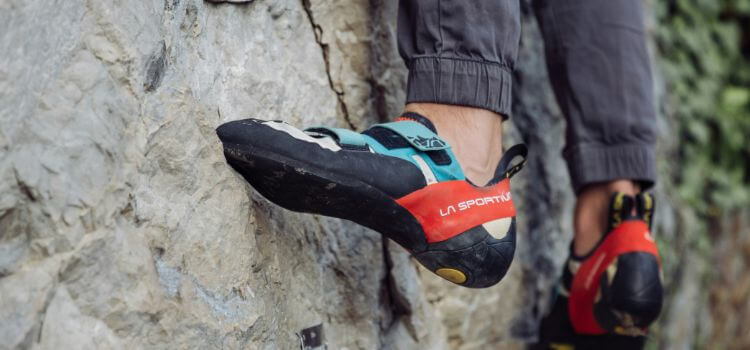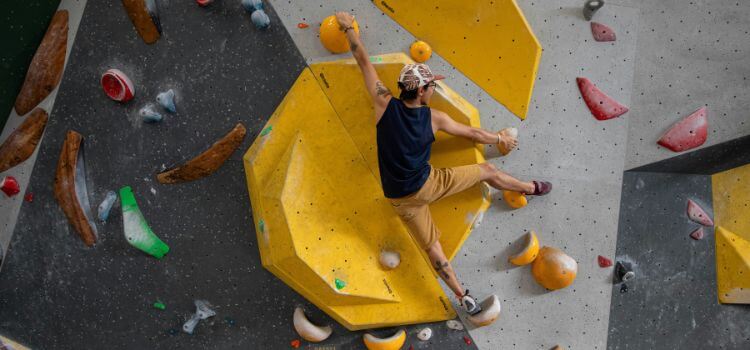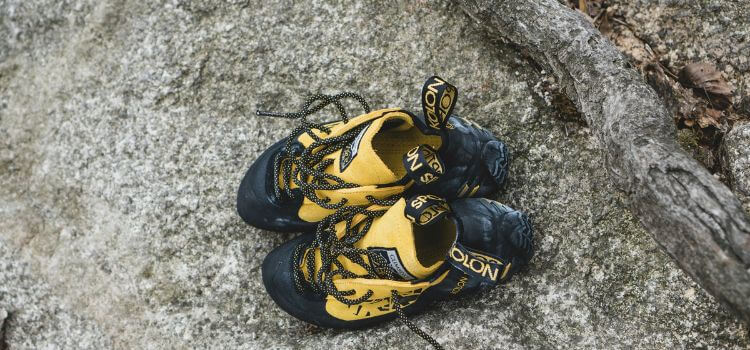As an Amazon Associate I earn from qualifying purchases.
Climbing shoes typically last between six months to a year with regular use. The frequency of use and climbing style influence their longevity.
Climbing shoes are essential gear for any climber, acting as the crucial contact point between the climber and the rock. A good pair of shoes can significantly affect performance, providing the grip and precision required for challenging routes. Durability is a key factor to consider when purchasing climbing shoes, as avid climbers will wear them quickly.

The type of climbing, from bouldering to sports routes, along with the terrain’s abrasiveness, plays a significant role in how long the shoes maintain their integrity and stickiness. Regular maintenance, such as cleaning and avoiding rough surfaces when not climbing, can extend their lifespan. For climbers hitting the walls multiple times a week, replacing shoes annually might be necessary to ensure optimal performance and safety.
Climbing Shoes’ Lifespan Essentials
Understanding a climbing shoe’s lifespan is crucial for climbers. These shoes face a lot of wear and tear. Knowing when to replace them is essential for performance and safety. We will delve into the elements that contribute to your climbing shoe’s longevity. Let’s break down the details.
Key Factors Influencing Durability
Multiple aspects determine how long climbing shoes last. Here’s what affects their lifespan:
- Frequency of use: More climbing means faster wear.
- Type of climbing: Rough rocks can degrade shoes quickly.
- Climber’s style: Smooth technique leads to less shoe damage.
- Maintenance: Proper care extends shoe life.
- Fit: Well-fitting shoes wear out evenly.
- Resolving: Timely resoling can save the shoes.
Material And Design Impact On Longevity
The material and design of climbing shoes are vital for their endurance. Different materials react to stress differently.
| Material | Features | Impact on Longevity |
| Leather | Stretchable, molds to foot | Lasts longer with care |
| Synthetic | Less stretch, consistent fit | May wear out faster than leather |
| Rubber | Grip and friction provider | Resoling is required with regular use |
Shoe design also impacts how long they can last. Asymmetric shapes may offer performance but might wear out faster. Flat designs could be more durable for casual climbs.
Signs Of Wear And Tear
Climbing shoes are the foundation of a climber’s gear. Knowing the signs of wear and tear is vital when it’s time for a replacement. Let’s explore the key indicators.
Sole Thinning And Holes
Sole thinning directly impacts your grip on the rock. Look for thin spots where the rubber is sparse. You might find holes near the toe or ball of the foot, a clear sign that it’s time for new shoes or resoling.
| Area | Condition |
| Toe | Visible holes or extreme thinning |
| The ball of the Foot | Rubber is wearing thin or has punctures |
Rand Deterioration And Delamination
The rand, or rubber around the shoe’s toe, keeps the shape of climbing shoes. Watch for peeling or separation. Delamination can reduce protection and affect performance.
- Peeling Rand: Rubber separating from the upper.
- Soft Spots: Weakened areas in the rand.
- Sensitivity: Increased feeling through the toe area.
Regular checks can extend the life of your shoes. For top performance, address wear and tear promptly.
Maintenance Tips For Extended Use
Want your climbing shoes to last longer? Good maintenance is key!
Proper Cleaning Techniques
Keeping climbing shoes clean helps them last. Dirt and grime wear them down. Use a soft brush for surface dirt. For tough spots, gently wipe down with a damp cloth. Avoid washing machines as they can damage the shoes.
- Brush off loose dirt after every climb.
- Use a slightly damp cloth for sticky dirt.
- Air dry away from direct sunlight.
- Never force dry using a heater or dryer.
Ideal Storage Conditions
Storage affects your shoes’ lifespan. Could you keep them in a cool, dry place? Avoid damp areas. A breathable bag is perfect for this. Extreme temperatures may deform the rubber.
- Store in a ventilated area to reduce odor.
- Avoid leaving them in a car or in direct sunlight.
- Use a shoe tree to maintain shape.
Resolving: Giving Your Shoes A Second Life
Climbing shoes are a climber’s best friend. They keep a firm grip on the rock face. But what happens when the soles wear out? Resoling is the rejuvenation your trusty shoes need.

When To Consider Resoling
It’s time to resolve climbing shoes when:
- The rubber starts to get thin.
- Edges aren’t sharp anymore.
- Small holes begin to appear.
Don’t wait for complete sole failure. Act early to extend their life span.
Benefits Of Professional Resoling
Professional resoling breathes new life into shoes. The benefits are many:
| Benefit | Description |
| Cost Efficiency | Less expensive than new shoes. |
| Performance | Restored grip and comfort. |
| Environment | Reduces waste. Good for the planet. |
Choose experienced professionals for the best results. They use quality materials and techniques.
Impact Of Climbing Style On Wear
The longevity of climbing shoes greatly depends on how you climb. Different climbing styles can cause varied degrees of wear and tear. Knowing the impact of your climbing style is key to maximizing your shoe’s lifespan.
Bouldering Vs. Trad Climbing
Bouldering often involves intense, short routes. Shoes experience sharp, repetitive impacts. This can cause quicker degradation, especially in the toe area. Trad climbing generally sees more even wear as ascents tend to be longer and less aggressive. Consider these factors:
- Toe rubber: Bouldering can wear this quicker.
- Sole thickness: Trad routes may be more forgiving.
Gym Use Vs. Outdoor Adventures
Climbing shoes face different challenges in gyms compared to the great outdoors. Gym climbing exposes shoes to artificial holds and cleaner surfaces. This can result in slower wear on the soles but faster on the inside due to sweat and humidity. Outdoor climbing exposes shoes to rough rock surfaces, which can accelerate the wear on the outsole. Remember:
| Location | Wear Type |
| Gym | Interior wear, milder sole wear |
| Outdoors | Rapid outsole wear, upper material strain |
Choosing The Right Shoes For Longevity
Imagine climbing shoes that stay strong, climb after climb. Choosing the right pair means fewer replacements. Select shoes that balance comfort, grip, and endurance. A wise choice extends the life of your footwear and your climbing adventures.
Balancing Performance And Durability
Durability matters in the world of climbing. Yet, holding onto performance is key. Seek shoes that last longer without sacrificing the grip you need on the rock.
- Look for thick rubber soles; they resist wear.
- Snug fits yield better performance; tight enough.
- Material like leather often lasts and shapes to your foot.
- Stitching should be reinforced; it prevents early tears.
Top Brands Known For Endurance
A few brands stand out for robust climbing shoe designs. Their products deliver consistent quality.
| Brand | Model | Durability Features |
| La Sportiva | Mythos | Leather upper, Vibram sole |
| Scarpa | Instinct VS | Synthetic materials, XS Edge rubber |
| Five Ten | Anasazi Pink | Stealth C4 rubber, strong velcro straps |
Each brand crafts shoes to last through tough climbs. The soles grip well, and the materials don’t give up too soon. Your feet stay comfortable, so you focus on the climb, not your shoes.
Cost Analysis: Investment Vs. Lifecycle
Climbing shoes represent a significant investment for climbers. Analyzing the cost compared to their lifecycle helps climbers make informed buying decisions. Durability, performance, and cost factors are included in this equation.
Evaluating Price Against Shoe Life Expectancy
The life expectancy of climbing shoes varies greatly. Climbing frequency, style, and terrain all impact how long shoes last.
| Price Range | Expected Lifespan |
| $50-$100 | 6 months to 1 year |
| $100-$150 | 1-2 years |
| $150+ | 2 years+ |
Quality materials and construction define longevity. Cheaper options might need replacement sooner, increasing long-term costs.
Cost-benefit Ratio Of High-end Vs. Budget Options
High-end shoes incorporate advanced technology and materials. This often translates to a longer lifespan and better performance.
- Budget-friendly options are great for beginners.
- More expensive shoes may pay off for regular climbers.
- Consideration of cost-per-use can justify pricier options.
- Some shoes can be resoled, extending their life.
Balancing initial cost with potential longevity and performance is key. Invest wisely based on your climbing habits.
When To Retire Your Climbing Shoes
Rock climbers know that climbing shoes are essential gear. But it’s crucial to recognize when to retire them to maintain peak performance and safety. The lifespan of climbing shoes varies based on usage and care. Let’s look into the signs that it’s time for a new pair and what to do with the old ones.

Safety Considerations
Your climbing shoes should always help you, not hold you back or put you at risk. Here are vital signs that your shoes may no longer be safe:
- Worn-down soles that reduce traction and increase slippage risk
- Visible holes or deep thinning in the toe area
- Stretched-out uppers that compromise food security
- Non-functioning closure systems, which could be velcro, laces, or buckles
Consider the climbing you do. Aggressive bouldering or edging wears shoes out faster than moderate climbing activities. Retire your boots before they fail during a climb.
Recycling And Disposal Options
Don’t just throw away your worn-out climbing shoes! Here are some recycling and disposal options:
| Option | Description |
| Resoling | Extend the life of shoes with new soles |
| Donations | Give to gyms for new climbers to practice |
| Recycling Programs | Some brands offer to recycle old climbing shoes |
Remember, responsible disposal is part of being a sustainable climber. Explore creative ways to repurpose your shoes in your home or garden!
Frequently Asked Questions Of How Long Do Climbing Shoes Last
Climbing shoes typically last 6 to 12 months and are regularly worn. Durability depends on the frequency of climbs, climbing surface, and shoe quality. Regular maintenance can extend their lifespan.
Replace climbing shoes when they show significant wear or every 1-2 years with regular use. Comfort, performance, and safety dictate the frequency of new purchases.
Climbing shoes are worn out when the rubber sole thins significantly or develops holes. Noticeable loss of performance, such as reduced grip, also indicates wear. Damaged closures or straps suggest it’s time for new shoes.
Climbing shoes don’t have an official expiration date, but they can degrade over time. Regular use typically leads to wear within 1 to 2 years. Store climbing shoes in a cool, dry place to maximize their lifespan.
Conclusion
Durability is key to the life of climbing shoes, and attentive care often extends their lifespan. Factors like usage frequency, material quality, and maintenance habits shape their longevity. Embrace these insights to ensure your footwear sustains your climbing ambitions for climbs ahead.
Safeguard your investment – let your climbing shoes support your passion for as long as possible.
Amazon and the Amazon logo are trademarks of Amazon.com, Inc, or its affiliates.